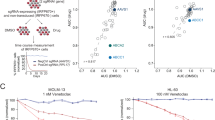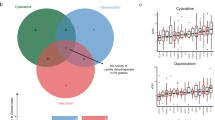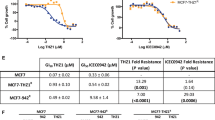Abstract
The multidrug resistance (MDR) phenotype, induced by the overexpression of several ABC transporters or by antiapoptotic mechanisms, has been identified as the major cause of drug resistance in the treatment of patients with acute myeloid leukemia (AML). In this study, we have shown that valproic acid (VPA) (a histone deacetylase inhibitor) can inhibit the proliferation of both P-glycoprotein (P-gp)- and MDR-associated protein 1 (MRP1)-positive and -negative cells. VPA also induced apoptosis of P-gp-positive cells. VPA induced apoptosis in K562 cells led to decrease in Flip (FLICE/caspase-8 inhibitory protein) expression with Flip cleavage, which could not be observed in HL60 cells. In HL60/MRP cell line, which proved to be resistant to apoptosis by VPA, we observed an abnormal expression of apoptotic regulatory proteins, overexpression of Bcl-2 and absence of Bax. Also, the Bcl-2 antagonist HA14-1 rapidly restored apoptosis in this cell line. Cotreatment with cytosine arabinoside induced very strong apoptosis in both K562/DOX and HL60/DNR cell lines. VPA also induced apoptosis in AML patient cells expressing P-gp and/or MRP1. Our findings show VPA as an interesting drug that should be tested in clinical trials for overcoming the MDR phenotype in AML patients.
This is a preview of subscription content, access via your institution
Access options
Subscribe to this journal
Receive 12 print issues and online access
$259.00 per year
only $21.58 per issue
Buy this article
- Purchase on Springer Link
- Instant access to full article PDF
Prices may be subject to local taxes which are calculated during checkout






Similar content being viewed by others
References
Simon SM, Schindler M . Cell biological mechanisms of multidrug resistance in tumors. Proc Natl Acad Sci USA 1994; 91: 3497–3504.
Germann UA . P-glycoprotein – a mediator of multidrug resistance in tumour cells. Eur J Cancer 1996; 32A: 927–944.
Legrand O, Simonin G, Beauchamp-Nicoud A, Zittoun R, Marie JP . Simultaneous activity of MRP1 and Pgp is correlated with in vitro resistance to daunorubicin and with in vivo resistance in adult acute myeloid leukemia. Blood 1999; 94: 1046–1056.
Legrand O, Perrot JY, Simonin G, Baudard M, Marie JP . JC-1: a very sensitive fluorescent probe to test Pgp activity in adult acute myeloid leukemia. Blood 2001; 97: 502–508.
Marks P, Rifkind RA, Richon VM, Breslow R, Miller T, Kelly WK . Histone deacetylases and cancer: causes and therapies. Nat Rev Cancer 2001; 1: 194–202, (review).
Johnstone RW . Histone-deacetylase inhibitors: novel drugs for the treatment of cancer. Nat Rev Drug Discovery 2002; 1: 287–299.
Kitamura K, Hoshi S, Koike M, Kiyoi H, Saito H, Naoe T . Histone deacetylase inhibitor but not arsenic trioxide differentiates acute promyelocytic leukaemia cells with t(11;17) in combination with all-trans retinoic acid. Br J Haematol 2000; 108: 696–702.
Rashid SF, Moore JS, Walker E, Driver PM, Engel J, Edwards CE et al. Synergistic growth inhibition of prostate cancer cells by 1 alpha,25 dihydroxyvitamin D(3) and its 19-nor-hexafluoride analogs in combination with either sodium butyrate or trichostatin A. Oncogene 2001; 20: 1860–1872.
Chang TH, Szabo E . Enhanced growth inhibition by combination differentiation therapy with ligands of peroxisome proliferator-activated receptor-gamma and inhibitors of histone deacetylase in adenocarcinoma of the lung. Clin Cancer Res 2002; 8: 1206–1212.
Kelly WK, Richon VM, O’Connor O, Curley T, MacGregor-Curtelli B, Tong W et al. Phase I clinical trial of histone deacetylase inhibitor: suberoylanilide hydroxamic acid administered intravenously. Clin Cancer Res 2003; 9 (Part 1): 3578–3588.
Gottlicher M, Minucci S, Zhu P, Kramer OH, Schimpf A, Giavara S et al. Valproic acid defines a novel class of HDAC inhibitors inducing differentiation of transformed cells. EMBO J 2001; 20: 6969–6978.
Kawagoe R, Kawagoe H, Sano K . Valproic acid induces apoptosis in human leukemia cells by stimulating both caspase-dependent and -independent apoptotic signaling pathways. Leukemia Res 2002; 26: 495–502.
Lacombe F, Belloc F, Dumain P, Puntous M, Lopez F, Bernard P et al. Quantitation of resistance of leukemic cells to cytosine arabinoside from BrdUrd/DNA bivariate histograms. Cytometry 1992; 13: 730–738.
Radosevic N, Delmer A, Tang R, Marie JP, Ajchenbaum-Cymbalista F . Cell cycle regulatory protein expression in fresh acute myeloid leukemia cells and after drug exposure. Leukemia 2001; 15: 559–566.
Sillaber C, Gesbert F, Frank DA, Sattler M, Griffin JD . STAT5 activation contributes to growth and viability in Bcr/Abl-transformed cells. Blood 2000; 95: 2118–2125.
Nimmanapalli R, Fuino L, Stobaugh C, Richon V, Bhalla K . Cotreatment with the histone deacetylase inhibitor suberoylanilide hydroxamic acid (SAHA) enhances imatinib-induced apoptosis of Bcr-Abl-positive human acute leukemia cells. Blood 2003; 101: 3236–3239.
Yu C, Rahmani M, Almenara J, Subler M, Krystal G, Conrad D et al. Histone deacetylase inhibitors promote STI571-mediated apoptosis in STI571-sensitive and -resistant Bcr/Abl+ human myeloid leukemia cells. Cancer Res 2003; 63: 2118–2126.
Peart MJ, Tainton KM, Ruefli AA, Dear AE, Sedelies KA, O’Reilly LA et al. Novel mechanisms of apoptosis induced by histone deacetylase inhibitors. Cancer Res 2003; 63: 4460–4471.
Ferrara FF, Fazi F, Bianchini A, Padula F, Gelmetti V, Minucci S et al. Histone deacetylase-targeted treatment restores retinoic acid signaling and differentiation in acute myeloid leukemia. Cancer Res 2001; 61: 2–7.
Mitsiades N, Mitsiades CS, Richardson PG, McMullan C, Poulaki V, Fanourakis G et al. Molecular sequelae of histone deacetylase inhibition in human malignant B cells. Blood 2003; 101: 4055–4062.
Vrana JA, Decker RH, Johnson CR, Wang Z, Jarvis WD, Richon VM et al. Induction of apoptosis in U937 human leukemia cells by suberoylanilide hydroxamic acid (SAHA) proceeds through pathways that are regulated by Bcl-2/Bcl-XL, c-Jun, and p21CIP1, but independent of p53. Oncogene 1999; 18: 7016–7025.
Johnstone RW, Ruefli AA, Lowe SW . Apoptosis: a link between cancer genetics and chemotherapy. Cell 2002; 108: 153–164, (review).
Yu C, Rahmani M, Conrad D, Subler M, Dent P, Grant S . The proteasome inhibitor bortezomib interacts synergistically with histone deacetylase inhibitors to induce apoptosis in Bcr/Abl+ cells sensitive and resistant to STI571. Blood 2003; 102: 3765–3774.
Almenara J, Rosato R, Grant S . Synergistic induction of mitochondrial damage and apoptosis in human leukemia cells by flavopiridol and the histone deacetylase inhibitor suberoylanilide hydroxamic acid (SAHA). Leukemia 2002; 16: 1331–1343.
Yu C, Subler M, Rahmani M, Reese E, Krystal G, Conrad D et al. Induction of apoptosis in BCR/ABL+ cells by histone deacetylase inhibitors involves reciprocal effects on the RAF/MEK/ERK and JNK pathways. Cancer Biol Ther 2003; 2: 544–551.
Aron JL, Parthun MR, Marcucci G, Kitada S, Mone AP, Davis ME et al. Depsipeptide (FR901228) induces histone acetylation and inhibition of histone deacetylase in chronic lymphocytic leukemia cells concurrent with activation of caspase 8-mediated apoptosis and down-regulation of c-FLIP protein. Blood 2003; 102: 652–658.
Suh WS, Kim YS, Schimmer AD, Kitada S, Minden M, Andreeff M et al. Synthetic triterpenoids activate a pathway for apoptosis in AML cells involving downregulation of FLIP and sensitization to TRAIL. Leukemia 2003; 17: 2122–2129.
Author information
Authors and Affiliations
Corresponding author
Additional information
Supplementary Information accompanies the paper on the Leukemia website (http://www.nature.com/leu).
Supplementary information
Rights and permissions
About this article
Cite this article
Tang, R., Faussat, AM., Majdak, P. et al. Valproic acid inhibits proliferation and induces apoptosis in acute myeloid leukemia cells expressing P-gp and MRP1. Leukemia 18, 1246–1251 (2004). https://doi.org/10.1038/sj.leu.2403390
Received:
Accepted:
Published:
Issue Date:
DOI: https://doi.org/10.1038/sj.leu.2403390
Keywords
This article is cited by
-
Edoxaban and the Issue of Drug-Drug Interactions: From Pharmacology to Clinical Practice
Drugs (2020)
-
Efficacy and safety of Levetiracetam vs. other antiepileptic drugs in Hispanic patients with glioblastoma
Journal of Neuro-Oncology (2018)
-
Spectroscopic and electrochemical studies on molecular recognition of tetrathiafulvalene derivative with P-glycoprotein and drug-resistant leukemia cells
Science China Chemistry (2015)
-
Pretreatment of leukemic cells with low-dose decitabine markedly enhances the cytotoxicity of gemtuzumab ozogamicin
Leukemia (2013)
-
3β-acetyl tormentic acid induces apoptosis of resistant leukemia cells independently of P-gp/ABCB1 activity or expression
Investigational New Drugs (2012)



